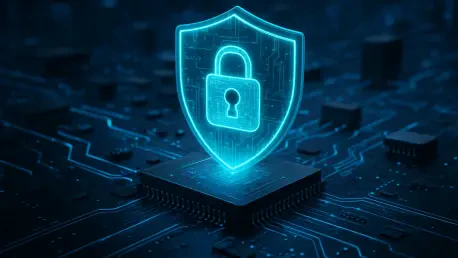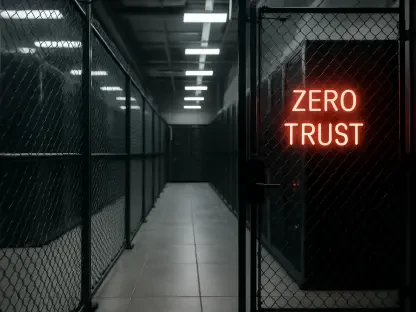In an era where digital interactions underpin nearly every aspect of daily life, the stakes for protecting sensitive information have never been higher, with cybercrime evolving into a sophisticated, organized threat that exploits even the smallest vulnerabilities. Data breaches can cripple organizations, erode public trust, and cause irreparable financial damage, while individuals face risks of identity theft and personal loss. The rapid pace of technological advancement, coupled with the increasing complexity of cyber threats, demands a fundamental shift in how security is approached. Traditional methods, once considered adequate, now fall short against tactics like ransomware and advanced phishing schemes. This pressing challenge sets the stage for exploring innovative strategies and proactive measures that can safeguard the digital landscape. By rethinking outdated practices and embracing adaptive frameworks, a path toward a more secure future becomes possible, ensuring that both organizations and individuals are equipped to face emerging dangers head-on.
Evolving Threats and the Need for New Strategies
Shifting from Reactive to Proactive Defenses
The cybersecurity landscape has transformed dramatically, with attackers employing advanced techniques that outpace conventional defenses like basic firewalls and antivirus software. A proactive stance, centered on anticipating threats before they materialize, is now essential. This involves continuous monitoring of networks to detect anomalies in real time and conducting regular risk assessments to uncover potential weaknesses. Adopting a zero-trust model, which operates on the principle that no user or device should be inherently trusted, ensures constant verification at every access point. Such an approach significantly reduces the likelihood of unauthorized access and limits the damage of potential breaches by compartmentalizing systems. Organizations that prioritize these forward-thinking measures position themselves to stay ahead of cybercriminals who exploit predictability. The focus on prevention rather than reaction marks a critical pivot in building resilience against an ever-changing array of digital threats.
Equally important is the need to understand the specific security posture of an organization or individual system, which requires a deep dive into the vulnerabilities that might exist across all digital touchpoints. Mapping out data flows and identifying critical assets helps in pinpointing where protections are most needed. Proactive strategies also mean investing in threat intelligence to stay informed about emerging attack patterns and adapting defenses accordingly. Unlike older methods that waited for an incident to occur before responding, this approach builds a dynamic shield that evolves with the threat landscape. By integrating tools for real-time analytics, potential issues can be flagged before they escalate into full-blown crises. This shift not only mitigates risks but also fosters confidence among stakeholders that their data remains secure. As cyber threats grow in sophistication, embedding these proactive principles into the core of security frameworks becomes a non-negotiable step for lasting protection.
Addressing the Human Factor in Security Risks
Human error remains a leading cause of cybersecurity breaches, often serving as the entry point for attackers through mistakes like clicking on malicious links or using weak passwords. Educating employees and individuals about these risks is a cornerstone of a robust defense strategy. Regular training programs that teach how to recognize phishing attempts, manage sensitive data, and follow secure protocols can significantly reduce inadvertent lapses. Building a culture of security awareness ensures that every person interacting with a system acts as a first line of defense rather than a potential liability. Such initiatives empower users to make informed decisions, turning human vulnerability into a strength. When paired with strict access controls, this focus on education creates a layered approach that addresses both technical and behavioral aspects of cybersecurity.
Beyond initial training, ongoing reinforcement through simulations and updates on the latest threat tactics keeps awareness sharp and relevant. For instance, mock phishing exercises can test how well individuals apply their knowledge in realistic scenarios, providing valuable feedback for improvement. Additionally, clear policies on password management and data handling set firm guidelines that minimize room for error. Encouraging a mindset where security is everyone’s responsibility helps bridge the gap between technology and human action. Unlike purely technical solutions that may overlook the human element, this dual focus ensures a more holistic defense. As cybercriminals increasingly target people as the weakest link, investing in education becomes just as critical as deploying advanced tools. Over time, these efforts cultivate a vigilant community that actively contributes to safeguarding digital environments against preventable threats.
Leveraging Technology and Best Practices for Robust Protection
Harnessing Automation and AI for Threat Detection
The integration of automation and artificial intelligence into cybersecurity marks a transformative leap in how threats are identified and managed in real time. AI-driven systems can analyze vast amounts of data to spot patterns indicative of potential attacks, often before they fully manifest. These technologies enable predictive analysis, allowing organizations to anticipate and neutralize risks with unprecedented speed. Automation further reduces the burden on human teams by handling repetitive tasks like log monitoring and initial threat responses, freeing up resources for strategic planning. By minimizing reliance on manual intervention, such tools enhance efficiency and accuracy in defending against complex cyber threats. The ability to adapt to new attack vectors through machine learning ensures that defenses remain relevant, offering a scalable solution for growing digital ecosystems.
Complementing these advancements, AI also supports rapid incident response by prioritizing alerts based on severity and providing actionable insights for mitigation. Unlike traditional systems that might overwhelm teams with false positives, intelligent algorithms refine their focus to highlight genuine risks. This precision not only saves time but also prevents critical threats from slipping through unnoticed. Additionally, automation can enforce consistent security policies across sprawling networks, ensuring no endpoint is left unprotected. The synergy of these technologies creates a formidable barrier that evolves alongside cybercriminal tactics. As the volume and sophistication of attacks continue to rise, embedding AI and automation into security operations offers a proactive edge. This approach redefines the speed and effectiveness of threat management, setting a new standard for protecting sensitive information in a dynamic digital age.
Prioritizing Regular Audits and Compliance Standards
Regular security audits play a pivotal role in identifying gaps within existing protocols, ensuring that vulnerabilities are addressed before they can be exploited by malicious actors. These assessments provide a comprehensive overview of an organization’s defenses, from software configurations to access controls, highlighting areas that require immediate attention. Compliance with industry standards and regulations further reinforces this process by aligning practices with proven benchmarks for data protection. Staying adherent to frameworks like GDPR or HIPAA not only mitigates legal risks but also builds trust with clients and partners who rely on robust security measures. Consistent evaluations create a feedback loop that drives continuous improvement, keeping systems resilient against evolving threats. This disciplined approach underscores the importance of accountability in maintaining a secure digital presence.
Beyond the technical benefits, audits also serve as a reminder of the need for adaptability in cybersecurity strategies, prompting updates to policies as new risks emerge. For example, evaluating the effectiveness of current encryption methods or incident response plans can reveal outdated practices that need modernization. Compliance checks, meanwhile, ensure that organizations meet obligations that protect user data, avoiding penalties and reputational damage. This combination of introspection and adherence to external standards fosters a culture of diligence that permeates every level of operation. Unlike sporadic efforts that might leave gaps unaddressed, a structured schedule of reviews guarantees sustained vigilance. By embedding these practices into routine operations, the foundation for long-term security is strengthened, offering peace of mind in an era where data breaches carry severe consequences. This commitment to rigor paves the way for enduring trust and stability.
Building a Resilient Future through Adaptive Measures
Reflecting on the strides made in cybersecurity, it becomes evident that transitioning from reactive fixes to proactive, comprehensive strategies has reshaped the battle against digital threats. The adoption of zero-trust models has fortified access controls, while extensive employee training has turned potential weaknesses into vigilant defenses. Automation and AI have revolutionized threat detection, providing speed and precision that manual efforts could scarcely match, and regular audits have ensured that no vulnerability lingers unnoticed. These efforts collectively establish a layered approach that addresses both technological and human dimensions of security. Looking ahead, the focus should shift to scaling these innovations through global collaboration, sharing threat intelligence to outpace cybercriminals. Investing in emerging technologies like quantum-resistant encryption could further secure data against future risks. By committing to continuous evolution and fostering a shared responsibility for digital safety, the groundwork laid in recent years promises a stronger, more resilient digital age.









